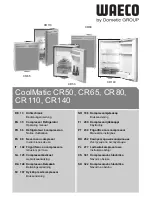
4–17
T-368
a DataLine
The DataLINE software for a personal computer is sup-
plied on both floppy disks and CD. This software allows
interrogation, configuration variable assignment,
screen view of the data, hard copy report generation,
cold treatment probe calibration, and file management.
Refer to Data Retrieval manual 62-10629 for a more
detailed explanation of the DataLINE interrogation soft-
ware. The DataLine manual may be found on the Inter-
net at www.container.carrier.com.
c. DataBANK Card
The DataBANK™card is a PCMCIA card that inter-
faces with the controller through the programming slot
and can download data at a fast rate. Files downloaded
to DataBANK card files are accessible through an
Omni PC Card Drive. The files can then be viewed
using the DataLINE software.
b. Communications Interface Module
The communications interface module is a slave module
which allows communication with a master central monitor-
ing station. The module will respond to communication and
return information over the main power line. With a remote
monitoring unit installed, all functions and selectable fea-
tures that are accessible at the unit may be performed at
the master station. Retrieval of all DataCORDER reports
may also be performed. Refer to the master system techni-
cal manual for further information.
4.8.10
USDA Cold Treatment
Sustained cold temperature has been employed as an
effective post harvest method for the control of Mediter-
ranean and certain other tropical fruit flies. Exposing
infested fruit to temperatures of 2.2°C (36°F) or below
for specific periods results in the mortality of the vari-
ous stages of this group of insects.
In response to the demand to replace fumigation with
this environmentally sound process, Carrier has inte-
grated Cold Treatment capability into its microproces-
sor system. These units have the ability to maintain
supply air temperature within one-quarter degree Cel-
sius of setpoint and record minute changes in product
temperature within the DataCORDER memory, thus
meeting USDA criteria. Information on USDA is pro-
vided in the following subparagraphs
a. USDA Recording
A special type of recording is used for USDA cold treat-
ment purposes. Cold treatment recording requires
three remote temperature probes be placed at pre-
scribed locations in the cargo. Provision is made to
connect these probes to the DataCORDER via recep-
tacles located at the rear left-hand side of the unit. Four
or five receptacles are provided. The four three-pin
receptacles are for the probes and fifth, five-pin, recep-
tacle is the rear connection for the Interrogator. The
probe receptacles are sized to accept plugs with tricam
coupling locking devices. A label on the back panel of
the unit shows which receptacle is used for each probe.
The standard DataCORDER report displays the supply
and return air temperatures. The cold treatment report
displays USDA #1, #2, #3, and the supply and return air
temperatures. Cold treatment recording is backed up by a
battery so recording can continue if AC power is lost.
b. USDA/ Message Trip Comment
A special feature is incorporated which allows the user
to enter a USDA (or other) message at the head of a
data report. The maximum message length is 78 char-
acters. Only one message will be recorded per day.
4.8.11
USDA Cold Treatment Procedure
The following is a summary of the steps required to ini-
tiate a USDA Cold Treatment:
a. Calibrate the three USDA probes by ice bathing
the probes and performing the calibration func-
tion with the DataLINE. This calibration proce-
dure determines the probe offsets and stores
them in the controller for use in generating the
cold treatment report. Refer to the Data
Retrieval manual 62-10629 for more details.
b. Pre-cool the container to the treatment tempera-
ture or below.
c. Install the DataCORDER module battery pack (if
not already installed).
d. Place the three probes. The probes are placed
into the pulp of the fruit (at the locations defined
in the following table) as the product is loaded.
e. To initiate USDA recording, connect the per-
sonal computer and perform the configuration
as follows, using the DataLINE software:
1. Enter ISO header information.
2. Enter a trip comment if desired.
3. Configure the DataCORDER for five probes
(s, r, P1, P2, P3) (dcf02=5).
4. Configure the logging interval for one hour.
5. Set the sensor configuration to “USDA”.
6. Configure for two byte memory storage for-
mat (dcf04=LONG).
7. Perform a “trip start.”
Sensor 1
Place in pulp of the product located next
to the return air intake.
Sensor 2
Place in pulp of the product five feet
from the end of the load for 40
−
foot con-
tainers, or three feet from the end of the
load for 20
−
foot containers. This probe
should be placed in a center carton at
one-half the height of the load.
Sensor 3
Place in pulp of product five feet from
the end of the load for 40
−
foot contain-
ers or three feet from the end of the load
for 20
−
foot containers. This probe
should be placed in a carton at a side
wall at one-half the height of the load.
Downloaded from
Summary of Contents for 69NT40-541-505
Page 2: ...Downloaded from ManualsNet com search engine...
Page 4: ...Downloaded from ManualsNet com search engine...
Page 10: ...Downloaded from ManualsNet com search engine...
Page 14: ...Downloaded from ManualsNet com search engine...
Page 18: ...Downloaded from ManualsNet com search engine...
Page 80: ...Downloaded from ManualsNet com search engine...
Page 86: ...Downloaded from ManualsNet com search engine...
Page 92: ...Downloaded from ManualsNet com search engine...
Page 124: ...Downloaded from ManualsNet com search engine...
Page 125: ...Downloaded from ManualsNet com search engine...
Page 126: ...Downloaded from ManualsNet com search engine...
Page 142: ...Downloaded from ManualsNet com search engine...
















































